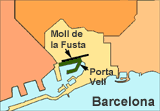Porta Vell: Moll de la Fusta
Location: The Porta Vell (Old Port) district is Barcelona's inner harbor. In the years before the 1992 Olympics, which Barcelona hosted, it was transformed from a grimy working seaport into a recreational, commercial, and entertainment center that includes a huge shopping center and Europe's largest aquarium. Among its landmarks is the two-tiered Moll de la Fusta (timber wharf), which is both a long waterfront promenade lined by restaurants and terraces and a system of walkways and streets that manages the circulation of pedestrians and vehicles as separate layers. It parallels Passeig de Colom, a wide boulevard lined with palm trees, which runs from the Columbus monument (at the foot of The Ramblas) to the Central Post Office.
History: Until the 1980s Porta Vell was a bustling area of docks and warehouses that blocked access to the Mediterranean, fueling Barcelona's reputation as a city that turned its back to the sea. The redevelopment of the waterfront began in the early 1980s as part of a larger project to rebuild the city's public spaces. One of the goals was a 50-50 split of the Barcelona waterfront between public space and seaport. Moll de la Fusta was the first step in gaining that balance. It opened in 1987 after four years of development and provided Barcelona both a new civic face and a new gateway to the sea.
Physical context: The Moll de la Fusta is multi-tiered and multi-layered.
|
|
 Back to Barcelona story Back to Barcelona story

It consists of a heavily traveled, tree-lined boulevard that is part of the city's ring road, an elevated platform holding pergolas and other urban furniture, and a pedestrian walkway paved in granite and lined with evenly spaced palm trees. A lower level has parking spaces and secondary roads.
In all, the Moll covers an area of 61,710 square meters (664,000 square feet).
It is designed to allow a relatively uninterrupted flow of pedestrians, and separates the partially submerged roadway and parking lot from the outside by a series of large stone arches. There are many distinctive architectural elements, including two bright red metal drawbridges, flowing ramps, and floating cantilevered roofs.
The project: The Moll de la Fusta was developed in conjunction with the renovation of an adjacent seaside working-class neighborhood known as Barceloneta. The project's took the following into consideration:
Restoration of the connection between the city and the waterfront by ensuring pedestrian access across the Passeig de Colom boulevard, while at the same time maintaining traffic flow along an important coastal road;
Demolition of dilapidated buildings, including the warehouses that lined the Moll de la Fusta;
An upgrade of the rental housing in the district;
|
|
Improvements to building facades, streets, and traffic flow.
Architect: Manuel Solŗ-Morales, founder of the Urban Planning Laboratory in Barcelona.
Atmosphere: Porta Vell is now a vibrant recreation, shopping and entertainment area by day and night, especially for young people. Moll de la Fusta draws a constant stream of strollers, people watchers, and sun worshippers. It essentially extends The Ramblas to the sea. And like The Ramblas, it contains significant works of art, including Roy Lichtensteinís Barcelona Head and Javier Mariscalís Gambrinus lobster. A new drawbridge connects Moll de la Fusta with Moll d'Espanya, a huge pier containing the distinctive, modernist Maremàgnum mall, the work of architects Helio Piñón and Albert Viaplana. Maremàgnum has 50 shops, more than two dozen restaurants, and a complex of movie theaters. Moll d'Espanya also holds the Barcelona Aquarium, Europe's largest.
Lessons learned: The Moll de la Fusta demonstrates that traditionally laid out streets within a city can be refined to accommodate modern needs. The Central Artery land presents Boston with a similar opportunity to combine a solution to traffic problems with the need to redefine the edges and contours of public space and repair tears in the existing urban fabric.
This case study was compiled by MIT researchers Alex-Ricardo Jimenez and Zhan Guo, under the direction of Thomas Piper of the Dept. of Urban Studies and Planning.
|



